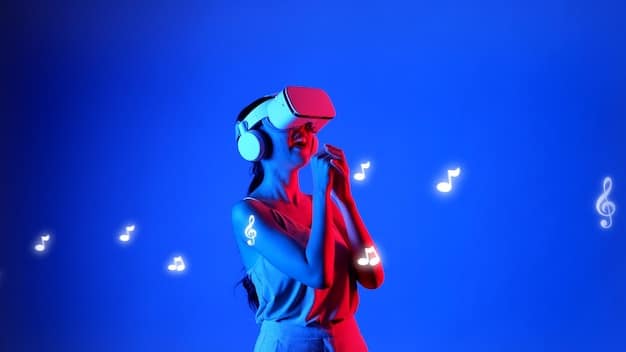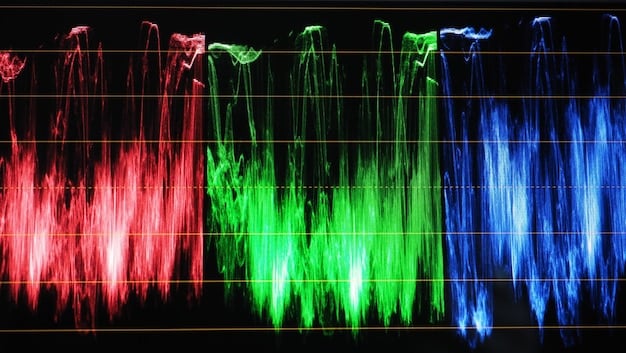The Evolution of Music Journalism: Underground Rap Coverage in 2025

In 2025, music journalism covering underground rap is expected to evolve through immersive media, data-driven insights, and artist-community collaborations, overcoming challenges like authenticity and bias.
The way we consume and understand music is constantly shifting, and music journalism is evolving right alongside it. By 2025, the landscape of music journalism, particularly in the realm of underground rap, will look drastically different. This article explores the evolution of music journalism: how underground rap is being covered in 2025, and the trends, technologies, and challenges shaping this dynamic field.
The Rise of Immersive Journalism
Immersive journalism is set to revolutionize how we experience and report on music. No longer will readers be confined to text and static images; instead, they will step into the world of underground rap through virtual reality (VR) and augmented reality (AR) experiences. These technologies offer a more profound connection to the music and the culture surrounding it.
VR Concert Experiences
Imagine attending a virtual underground rap concert from the comfort of your home. VR technology can transport listeners to intimate venues, allowing them to experience the energy and atmosphere of a live performance. This offers a unique opportunity for fans who may not have access to these events otherwise.
AR Enhanced Articles
Augmented reality can transform static articles into interactive experiences. Readers can use their smartphones to scan images and unlock exclusive content, such as behind-the-scenes footage, interviews, and 3D models of album art. This brings a new layer of depth to music journalism, making it more engaging and informative.

Here are some ways immersive journalism will reshape underground rap coverage:
- Deeper Engagement: VR and AR provide a more immersive and emotional connection to the music and the artists.
- Expanded Access: Fans can experience concerts and events regardless of their location or financial constraints.
- Enhanced Storytelling: Journalists can use these technologies to create more compelling and multi-dimensional narratives.
In conclusion, immersive journalism represents a paradigm shift in music reporting, offering new ways for audiences to connect with underground rap culture. By leveraging VR and AR, journalists can create more engaging and informative experiences that transcend the limitations of traditional media.
Data-Driven Music Journalism
Data analytics is becoming an increasingly important tool in music journalism. By analyzing streaming data, social media trends, and audience demographics, journalists can gain deeper insights into the popularity and impact of underground rap music. This data can be used to inform reporting, identify emerging trends, and provide a more nuanced understanding of the genre.
Identifying Emerging Artists
Data analytics can help journalists identify up-and-coming underground rap artists before they break into the mainstream. Social media sentiment analysis and streaming data can reveal artists who are generating buzz and gaining a loyal following. This allows journalists to cover these artists early in their careers, providing valuable exposure and helping them reach a wider audience.
Understanding Audience Demographics
By analyzing audience demographics, journalists can gain a better understanding of who is listening to underground rap music and why. This information can be used to tailor content to specific audiences and create more relevant and engaging stories. Data on age, location, and interests can provide valuable context for reporting.

Data-driven insights will reshape underground rap coverage in several ways:
- Predictive Analysis: Using data to forecast emerging trends and identify future stars.
- Audience Segmentation: Tailoring content to specific demographics based on listening habits and preferences.
- Impact Measurement: Quantifying the influence of underground rap on broader cultural conversations.
In conclusion, data-driven music journalism offers a more objective and analytical approach to covering underground rap. By leveraging data, journalists can provide valuable insights into the genre’s popularity, impact, and future direction.
The Role of Social Media and User-Generated Content
Social media has always been an integral part of the music industry, but its role in music journalism is becoming even more pronounced. Platforms like TikTok, Instagram, and Twitter are now primary sources for news, trends, and artist-fan interactions. User-generated content (UGC) is also playing a larger role, with fans creating reviews, remixes, and reaction videos that contribute to the overall narrative.
TikTok as a Discovery Platform
TikTok has become a breeding ground for underground rap artists. Short, catchy tracks can go viral overnight, catapulting unknown artists into the spotlight. Music journalists are now using TikTok to discover new talent and track emerging trends in the genre.
Fan-Driven Reviews and Commentary
User-generated content is disrupting traditional music criticism. Fans are creating their own reviews, commentary, and analyses of underground rap music, often providing more authentic and relatable perspectives. This democratizes the process of music journalism, giving a voice to those who are closest to the culture.
The influence of social media and UGC will manifest through:
- Real-Time Reporting: Social media providing instant updates on events, releases, and artist activities.
- Interactive Storytelling: UGC integrated into articles to showcase diverse perspectives.
- Community Building: Online platforms fostering discussions and collaborations between artists, fans, and journalists.
In conclusion, social media and user-generated content are transforming music journalism by making it more participatory and community-driven. Journalists must adapt to this new landscape by embracing these platforms and incorporating UGC into their reporting.
Collaboration Between Artists and Journalists
The traditional relationship between artists and journalists is evolving. In the past, journalists often acted as gatekeepers, deciding which artists would receive coverage and exposure. Today, there is a growing trend towards collaboration, with artists and journalists working together to create content that is both informative and engaging.
Artist-Led Documentaries
Some underground rap artists are taking matters into their own hands by creating their own documentaries and behind-the-scenes content. This allows them to control their narrative and connect directly with their fans. Journalists can collaborate with these artists to provide additional context and analysis.
Joint Interviews and Podcasts
Collaborative interviews and podcasts are becoming more common, with artists and journalists sharing the stage to discuss music, culture, and current events. This provides a more balanced and nuanced perspective, allowing both parties to contribute their unique insights.
Here’s how the collaboration can bring a change:
- Authentic Narratives: Artists co-creating content to ensure accurate representation and storytelling.
- Deeper Analysis: Journalists providing critical context and analysis to artists’ work.
- Enhanced Engagement: Joint ventures resulting in more comprehensive and engaging content for fans.
In conclusion, collaboration between artists and journalists is essential for creating high-quality, informative, and engaging content about underground rap. This approach fosters trust and mutual respect, leading to more authentic and meaningful stories.
The Importance of Diversity and Inclusion
Diversity and inclusion are critical values in music journalism. The underground rap scene is incredibly diverse, with artists from all backgrounds and experiences. It is important for music journalists to reflect this diversity in their reporting, giving voice to marginalized communities and challenging dominant narratives.
Highlighting Underrepresented Voices
Music journalists have a responsibility to amplify the voices of underrepresented groups in the underground rap scene. This includes women, LGBTQ+ individuals, and artists from marginalized racial and ethnic backgrounds. By giving these artists a platform, journalists can help to create a more equitable and inclusive music industry.
Challenging Stereotypes and Biases
It is important for music journalists to be aware of their own biases and stereotypes when reporting on underground rap. The genre has often been subject to negative stereotypes and misrepresentations in the media. Journalists must actively challenge these stereotypes and provide a more nuanced and accurate portrayal of the culture.
Ensuring diversity and inclusion requires:
- Equitable Representation: Actively seeking out and highlighting artists from diverse backgrounds.
- Cultural Sensitivity: Approaching stories with an understanding and respect for different cultures.
- Challenging Norms: Questioning and dismantling stereotypes and biases in reporting.
In conclusion, diversity and inclusion are essential for ensuring that music journalism accurately reflects the richness and complexity of the underground rap scene. By giving voice to marginalized communities and challenging stereotypes, journalists can help to create a more just and equitable music industry.
Challenges and Ethical Considerations
As music journalism evolves, it faces several challenges and ethical considerations. The rise of social media and user-generated content has made it more difficult to verify information and maintain journalistic standards. Additionally, the close relationship between artists and journalists can create conflicts of interest. It is important for journalists to be aware of these challenges and to adhere to the highest ethical standards.
Maintaining Authenticity in Reporting
In the age of social media, it can be difficult to distinguish between genuine voices and manufactured narratives. Music journalists must be vigilant in verifying information and seeking out authentic perspectives. This requires critical thinking, thorough research, and a commitment to truth-telling.
Avoiding Conflicts of Interest
The close relationship between artists and journalists can create conflicts of interest. Journalists must be transparent about their relationships with artists and avoid accepting gifts or favors that could compromise their objectivity. It is important to maintain a professional distance and to prioritize the public interest.
Ethical journalism requires commitment to:
- Verifying Information: Ensuring accuracy by cross-referencing sources and conducting thorough research.
- Maintaining Objectivity: Avoiding biases and conflicts of interest in reporting.
- Protecting Sources: Respecting confidentiality and ensuring the safety of sources.
In conclusion, ethics and challenges are unavoidable as music evolution occurs. It is important for journalists to be aware of these challenges and to adhere to the highest ethical standards. By doing so, they can maintain the trust of their readers and uphold the integrity of music journalism.
The Future of Music Journalism
The future of music journalism is bright. As technology continues to evolve, journalists will have access to new tools and platforms for storytelling. Immersive journalism, data analytics, and collaborative partnerships will transform the way we report on music, creating more engaging, informative, and meaningful experiences for audiences.
AI-Assisted Reporting
Artificial intelligence (AI) has the potential to revolutionize music journalism. AI tools can be used to transcribe interviews, analyze data, and generate reports. This can free up journalists to focus on more creative and analytical tasks. However, it is important to use AI responsibly and to ensure that it does not compromise journalistic integrity.
Personalized Content Experiences
In the future, music journalism will become increasingly personalized. Algorithms will analyze users’ listening habits, preferences, and social media activity to create customized content experiences. This will allow journalists to deliver the right content to the right audience at the right time.
The future holds promise in:
- AI Integration: Using AI to streamline research and create more efficient workflows.
- Personalized Content: Tailoring content to individual preferences and interests.
- Interactive Platforms: Creating immersive experiences that engage audiences on multiple levels.
In conclusion, the future of music journalism is dynamic and evolving. New tech and platforms will elevate and transform the way we report on music and increase user engagement . As long as journalists adhere to ethical standards and responsible reporting, the future looks bright.
| Key Point | Brief Description |
|---|---|
| 🎧 Immersive Journalism | VR/AR enhance music experience, providing virtual concerts and interactive articles. |
| 📊 Data-Driven Insights | Data analytics uncovers emerging artists and understands audience demographics. |
| 📱 Social Media’s Role | TikTok and UGC drive trends and fan-driven reviews in music journalism. |
| 🤝 Collaboration | Artists and journalists collaborate for authentic narratives and deeper analysis. |
FAQ
▼
VR and AR technologies will offer immersive experiences like virtual rap concerts and interactive articles, deepening audience engagement and expanding access to underground music events.
▼
Fan-generated content, like reviews and reaction videos, democratizes music criticism, providing authentic perspectives and contributing to the overall narrative of underground rap culture.
▼
Collaboration fosters trust and respect, leading to more authentic stories and enhanced content. Joint interviews and artist-led documentaries offer a balanced, nuanced perspective.
▼
By highlighting underrepresented voices and challenging stereotypes, music journalists help create a more equitable music industry, accurately reflecting the richness of underground rap.
▼
Challenges include verifying information on social media, maintaining objectivity, and avoiding conflicts of interest. Adhering to high ethical standards is crucial for maintaining trust.
Conclusion
In 2025, the evolution of music journalism promises a new era of immersive, data-driven, and collaborative storytelling within the underground rap scene. By tackling ethical challenges and embracing diversity, the industry can ensure that these future trends result in a deeper and more meaningful understanding of music for all audiences.





